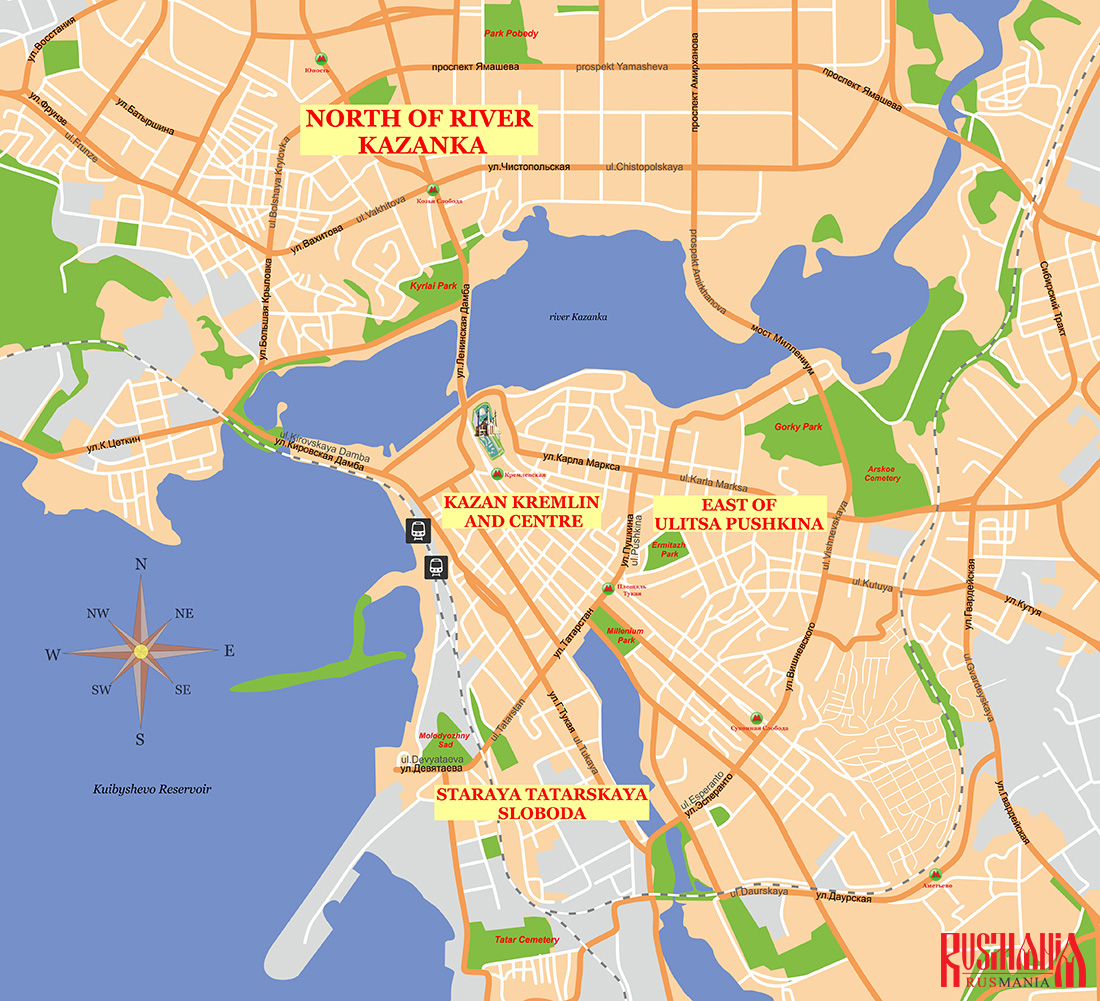Sights of Kazan
Around Ulitsa Baumana
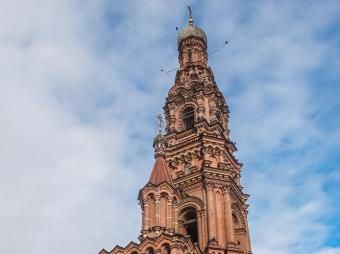
Epiphany Cathedral
- 78 Ulitsa Baumana
The Epiphany Cathedral was built in 1741 and subsequently extended in 1756. After the Revolution, the cathedral remained open for longer than other churches, but it too was eventually closed from 1939 until 1996. During this time it was used as a store and as a sports hall. It has since undergone reconstruction work and the pale-blue cathedral's golden domes have been restored having been removed in the Soviet era. The cathedral though is completely overshadowed by its wonderful… Read more »
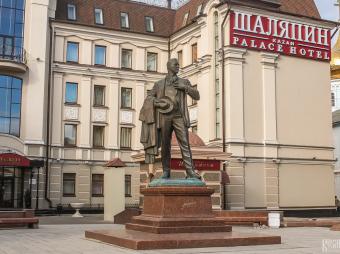
Fyodor Shalyapin Monument
- outside 80 Ulitsa Baumana
The world-renowned Russian opera singer Fyodor Shalyapin (also spelled Chaliapin) was born in Kazan in 1873 and lived there until he was 17, gaining his first experiences of singing in public in a church choir in the city. This monument was unveiled in 1999 on the 125th anniversary of Shalyapin's birth. Read more »
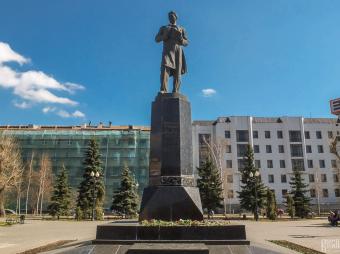
Ğabdulla Tuqay Monument
- Skver Gabdully Tukaya
Skver Gabully Tukaya (Ğabdulla Tuqay Gardens) just off Ploschad Tukaya (Tuqay Square) unsurprisingly features a statue of Ğabdulla Tuqay (also transliterated as Gabdulla Tukai) who is one of the most famous Tatar poets and is credited with being the founder of modern Tatar literature. Tuqay was born in the Kazan Governorate in 1886 and died in Kazan just before his 27th birthday in 1913. Tuqay is buried in the Tatarskoe Cemetery in the south of Kazan. Read more »
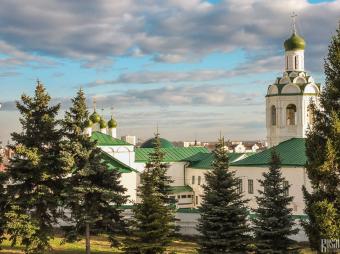
Ioanno-Predtechensky Monastery
- 2 Ulitsa Baumana
The Ioanno-Predtechensky Monastery was founded by St German, Bishop of Kazan, sometime between 1564 and 1568 and is dedicated to St John the Baptist (known as Ioann Predtech in Russian). Originally it was established as a podvorye (a representation church) of the Sviyazhsky Uspensky Monastery, also founded by St German. The original wooden buildings were destroyed by fire in 1649 and then replaced with stone buildings. The monastery's Presentation of Mary Church dates from this… Read more »
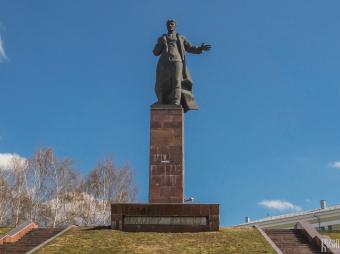
Mullanur Vakhitov Monument
- Skver Vakhitova
Standing at the top of the hill on Ploschad Tukaya (Tuqay Square) is a statue of the Tatar revolutionary Mullanur Vakhitov. Vakhitov was born in the Perm Governorate in 1885 and became interested in the Social-Democrat movement at college. He later took part in the 1905 Revolution in Kazan and became a member of the Bolshevik Party. After Kazan was captured by the White Army in August 1918, Vakhitov was arrested and executed. This statue of him was unveiled in 1985 on the 100th… Read more »
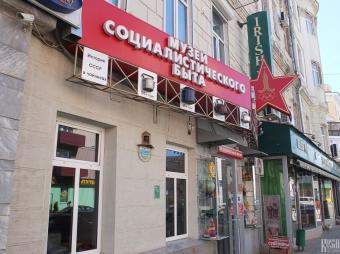
Soviet Life Museum
- 6 Ulitsa Universitetskaya
- http://muzeisb.ru/
- 11:00 - 19:00. Daily.
The Museum of Soviet Life was opened in 2011 after an exhibition entitled "Jeans as a Cult" proved popular in the city. The city authorities allocated a former communal apartment (kommunalka) to house the museum; a fitting location for such a museum. The museum now has various exhibits recreating everyday life in the Soviet Union in the 1970s and 1980s. Special attention is dedicated to Soviet schools, the Soviet army, music of the period (both Soviet and Western), socialist art… Read more »

St Nicholas' Eparchial Cathedral
- 5 Ulitsa Baumana
St Nicholas' Eparchial Cathedral is better described as an architectural complex comprising three buildings: a bell tower and two churches. The five-domed Intercession Church which dates from the turn of the 18th century and the adjacent turquoise-coloured St Nicholas' Church which was completed in 1885. The complex was closed in 1930, but Archbishop Hermogenes of Kazan managed to persuade the authorities to reopen it in 1946, from which moment it became the Eparchial Cathedral of… Read more »
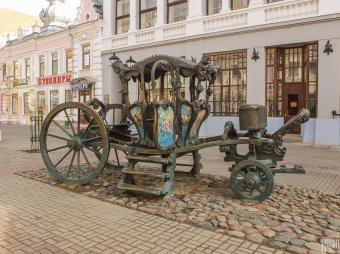
Ulitsa Baumana
- Ulitsa Baumana
Until 1930 Ulitsa Baumana was known as Ulitsa Prolomnaya as according to local legend it was here that Russian troops broke through the city's defences (prolomit being the Russian for ‘to break through’). Many of Kazan's sights are located nearby, but the street itself is also an attraction for the statues, fountains and other decorations found here. One such statue is Catherine the Great's Carriage, which is an exact life-size copy of the carriage given to the city by Catherine… Read more »
Around Ulitsa Karla Marksa
Baqi Urmançe Museum
- 20 Ulitsa Schalova
- http://www.antat.ru/
On the other side of Lydskoy Sad is the Baqi Urmançe Museum which was created in 1998 to celebrate the work and life of one of Tatarstan's finest artists - Baqi Urmançe (also transliterated as Baki Urmanche) - who died in Kazan in 1990. Urmançe's work includes paintings, graphic work, sculptures, book illustrations, decorative applied art and theatre decorations and the museum has on display 65 original pieces and over 150 documents and photographs. It also features a memorial part… Read more »
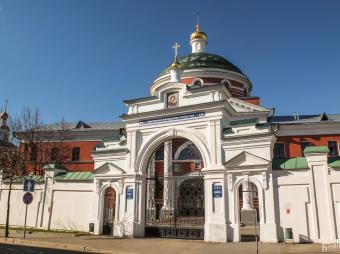
Bogoroditsky Monastery
- 5 Ulitsa Bolshaya Krasnaya
In 1579 after Kazan had been damaged by a great fire, a 10-year old girl called Matrona had a dream in which the Virgin Mary appeared and told her that she would find an icon among the ashes. As predicted Matrona found the icon depicting the Virgin Mary holding the Infant Christ. Tsar Ivan the Terrible considered that finding this miraculous icon was a blessing from heaven of his conquest of Kazan and ordered that a convent be founded on the spot where the icon was found. The… Read more »

Gavriil Derzhavin Monument
- Lyadskoy Sad
Situated in the park off Ulitsa Gorkogo known as Lyadskoy Sad is a statue of the Russian poet and statesman Gavriil Derzhavin. Derzhavin was born in the Kazan Governorate and was a descendent of a Tatar prince who left the Golden Horde to serve Grand Prince Vasili II. In 1802 Derzhavin became the Russian Empire's first minister of Justice. This statue was unveiled in 2003, but is a reproduction of the statue which stood in Kazan from 1846 until 1932. Read more »
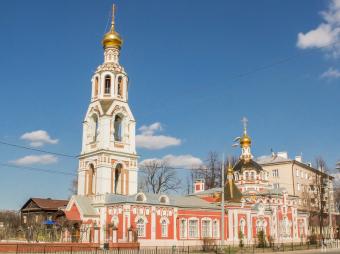
Great Martyr Barbara's Church
- 67 Ulitsa Karla Marksa
Great Martyr Barbara's Church was originally built in the end of the 18th century to meet the needs of the local cemetery, but later it became a parish church in its own right. By the turn of the 20th century the church had fallen into disrepair and was rebuilt in the Russian classical style. In 1930 the church was closed and used as a club for tram workers. It was eventually returned to the Orthodox Church in 1994 and subsequently restored. Read more »
Maksim Gorky Literary-Memorial Museum
- 10 Ulitsa Gorkogo
- http://www.kazan1000.ru/rus/museum/Gorki.htm
- 10:00 – 17:00. Closed on Fridays.
- Free entry on the first Wednesday of the month.
The Maksim Gorky Literary-Memorial Museum was opened in 1940 in the former house where Aleksey Peshkov worked as a cook from 1886 to 1887 before adopting his penname of Maksim Gorky and becoming a famous author. Peshkov came to Kazan to enrol at the Kazan Imperial University, but when this became impossible he took up manual work in the city. The museum contains exhibitions on Gorky and his family as well as on Fyodor Shalyapin (also spelled Chaliapin), the famous Russian opera… Read more »
Musa Cälil Apartment-Museum
- apartment 28, 17 Ulitsa Gorkogo
- http://www.tatar.museum.ru/jalil/
- 10:00 – 17:00. Closed on Sundays.
In 1983 the Musa Cälil Apartment-Museum was founded in the apartment where the poet lived from 1940 until he went to war in 1941. The first room's interior has been recreated to how it looked when Cälil lived there and the second room has exhibitions on the life and work of the poet, including the notebooks in which he wrote his famous work - the Moabit Notebooks. Read more »

Museum of the Millennium of Kazan
- Kazan National Cultural Centre, Sultan Galieva Square (86 Ulitsa Pushkina)
- http://www.kazan1000.ru/rus/museum/tisacha.htm
The Museum of the Millennium of Kazan was opened in 2005 as part of Kazan's millennium celebrations in the Kazan National Cultural Centre. The modern museum comprises three sections, the first dedicated to ancient Kazan and Volga Bulgaria, the second to Kazan as part of the Russian Empire and the third to Kazan during the Soviet times and the modern era. Each section displays a whole range of documents, pictures and photographs, as well as especially commissioned models and artwork… Read more »
Näcip Cihanov Apartment-Museum
- apartment 11, 14 Ulitsa Malaya Krasnaya
- http://www.kazan1000.ru/rus/museum/tisacha.htm
- 10:00 - 17:00. Closed on weekends.
In 2001 the apartment where the composer Näcip Cihanov (also transliterated as Nazib Zhiganov) lived for 18 years of his life was turned into the Näcip Cihanov Apartment-Museum. From 1945 to 1988 Cihanov served as rector of the Kazan Conservatory, which is now named in his honour. The apartment-museum features the original furniture and has on display many original items and documents of the composer. Read more »
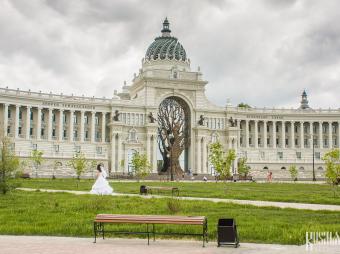
Palace of Agriculturalists
- Ulitsa Fedoseevskaya
The grand and rather extravagant Palace of Agriculturalists was built between 2008 and 2010 as the headquarters of the Ministry of Agriculture and Food Production. It is located on Ulitsa Feodoseevskaya which starts close to the beginning of Ulitsa Bolshaya Krasnaya and runs parallel with the River Kazanka. The palace was built amid some controversy due to its proximity to the UNESCO protected Kremlin, but nevertheless it has since become one of the most famous modern sights in… Read more »

Salix Säydäş House-Museum
- 13 Ulitsa Gorkogo
- http://www.tatar.museum.ru/Saydash/
- 10:00 – 17:00. Closed on Mondays.
The Salix Säydäş (also transliterated as Salikh Saidashev) House-Museum was opened in 1993 in the two-storey house where the famous Tatar composer and conductor lived from 1928 to 1954. The White Room in the museum serves as a memorial room for the composer and displays some of his personal items. The remainder of the museum is dedicated to the work of Säydäş. Read more »
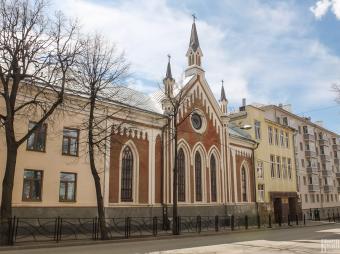
St Catherine’s Lutheran Church
- 26 Ulitsa Karla Marksa
There has been a Lutheran community in Kazan since the 16th century, mainly German immigrants. The construction of the first Lutheran Church began after Catherine the Great’s visit to Kazan in 1767 and was consecrated in 1771 in honour of St Catherine. The current version was built between 1862 and 1865 in the romantic style. During the Soviet years it was closed and used by the NKVD, as a furniture hall and as a sports club, eventually being returned to the Lutheran community in… Read more »
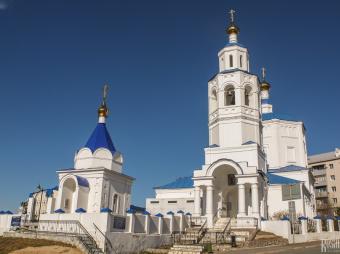
St Parascheva Pyatnitsa's Church
- 1 Ulitsa Bolshaya Krasnaya
The white St Parascheva Pyatnitsa's Church was completed in the early 18th century to serve as a place of worship for a local textile mill. The church is also known as the Nativity of Virgin Mary Church. In 1937 the church was closed and used as an NKVD prison, where prisoners were even executed. Afterwards the bell tower was destroyed and the building was left abandoned. The church was returned to worshipers in 1997 and underwent restoration work. Next to the church is the modern… Read more »

State Museum of Fine Arts of the Republic of Tatarstan
- 64 Ulitsa Karla Marksa
- http://izo-museum.ru/
- 10:00 – 17:00 (weekends: 10:00 – 16:00). Closed on Mondays.
- Free entry on the first Tuesday of the month.
The State Museum of Fine Arts of the Republic of Tatarstan is housed in the former Sandetsky Estate which dates from the early 19th century. The gallery has several collections including ancient, classical and modern Russian art, western and eastern art, decorative and applied art, graphic art and sculptures. The estate house's original heaters decorated with beautiful tiles do not look at all out of place among the artwork hanging on its walls. Read more »

Vasili Aksyonov House-Museum
- 55/31 Ulitsa Karla Marksa
- http://vk.com/domaksenova
- 10:00 - 18:00 (Saturdays: 10:00 - 16:00). Closed on Sundays.
Opposite to the State Museum of Fine Arts is the Vasili Aksyonov House-Museum. The Russian author, who is most famous for his ‘Generations of Winter’ saga, was born in Kazan in 1932. After his death in 2009, the house where he spent his childhood was turned into a museum detailing his life and work. In addition, the museum also runs a regular literary club and other events. Read more »

Vladimir Lenin Monument
- Ploschad Svobody
In a small park on Freedom Square, opposite the Musa Cälil State Academic Opera and Ballet Theatre is a statue of Vladimir Lenin in a familiar pose. Lenin lived in Kazan from September 1888 to May 1889 and briefly studied at Kazan University until he was expelled for his political activities. After his experience in Kazan, Lenin became even more determined to continue his struggle against autocracy. The building behind Lenin is the State Council of the Republic of Tatarstan. Read more »
Yevgeni Boratynsky House-Museum
- 25/28 Ulitsa Gorkogo
- http://tatar.museum.ru/Boratynsk/
- 10:00 - 17:00. Closed on Wednesdays.
- Free admission on the first Wednesday of the month.
In 1977 the Yevgeni Boratynsky Museum was opened in a school building and in the Boratynsky city estate. Boratynsky was a poet of the same era as Aleksandr Pushkin, who described Boratynsky as Russia’s finest elegiac poet. Boratynsky briefly lived in Kazan as his wife had an estate nearby. The museum has two main expositions: ‘The Boratynskys - Centuries in Kazan’, which details the Boratynsky family and its connection with the city, and the ‘Life and Work of Yevgeni Boratynsky’,… Read more »
Around Ulitsa Kremlyovskaya
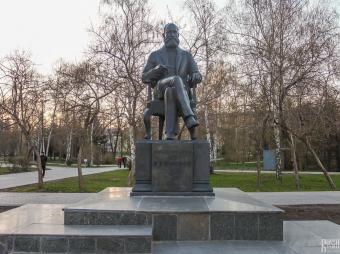
Aleksandr Butlerov Monument
- 29A Ulitsa Pushkina
Located at the entrance of Leninsky Sad (Lenin Gardens) off Ulitsa Pushkina is a statue of the Russian chemist Aleksandr Butlerov. Butlerov was born in Chistopol in the Kazansky Governorate in 1828 and after completing Kazan University went on to become one of the principle creators of the chemical structure theory. In addition, a street in Kazan is also named in his honour. Also to be found in Leninsky Sad is a simple memorial to victims of political repression. Read more »
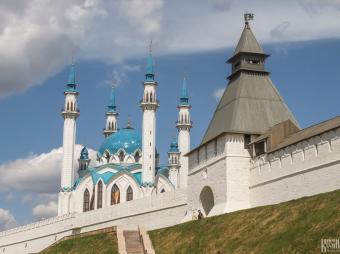
Kazan Kremlin
- Ploschad Pervogo Maya
- http://www.kazan-kremlin.ru
The Kazan Kremlin is located in the centre of Kazan on a high peninsular sticking out into the Kazanka and Volga Rivers. A fortress has been in this location since ancient times but the present kremlin was built on the orders of Tsar Ivan the Terrible after his conquest of Kazan in 1552. Pskov master architects were brought in to construct the 1,800 metres of walls and 13 towers. Today the kremlin is the heart of Kazan and its most famous sight. In 2000 it was inscribed on UNESCO’s… Read more »
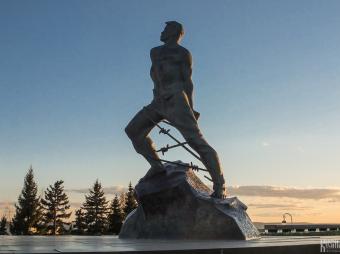
Musa Cälil Monument
- Ploschad Pervogo Maya
Just outside the main entrance to the kremlin is a monument to the famous Tatar poet Musa Cälil (also transliterated as Musa Dzhalil). The monument was unveiled in 1985 and depicts the poet defiantly standing on rocks while his hands are tied and his legs wrapped in barbed wire. During the Second World War, Cälil was captured by the Nazis and spent time in concentration camps until he was released to fight against the Soviets in a Nazi legion made up of Volga Tatars. However Cälil… Read more »
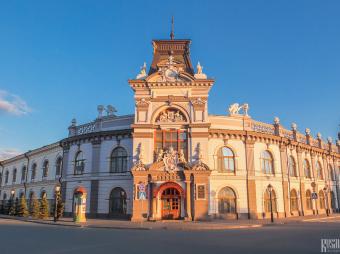
National Museum of the Republic of Tatarstan
- 2 Ulitsa Kremlyovskaya
- http://tatar.museum.ru/nm/
- 10:00 – 18:00. Closed on Mondays.
- Free entry on the first Wednesday of the month.
Near to the kremlin on the other side of Ploschad Pervogo Maya is the National Museum of the Republic of Tatarstan which is located in a beautiful old building. A museum has been housed here since 1895 and is based on the collection of local historian Andrey Likhachev. Now the museum serves as the foremost museum of Tatar culture and history. The most interesting exhibitions include the carriage of Empress Catherine II which she gave the city after her visit, old coins from the… Read more »
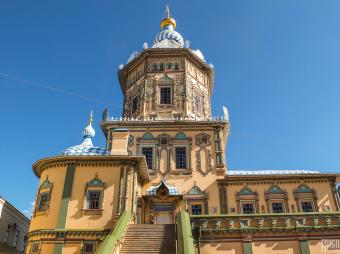
Ss Peter and Paul’s Cathedral
- 21 Ulitsa Musy Dzalilya
Ss Peter and Paul's Cathedral was built between 1723 and 1726 during the reign of Peter the Great. The cathedral is a wonderful example of the Russian baroque style popular under Peter the Great. It stands at 52 metres tall and is decorated with ornate details. Adjacent to the cathedral stands a 49-metre, six-tier bell tower, decorated in the same style. In its history the cathedral has been badly damaged by fire and subsequently restored several times. The Bolsheviks closed the… Read more »
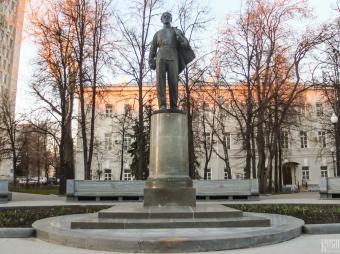
Vladimir Lenin Monument
- 18 Ulitsa Kremlyovskaya
In the small park opposite the Kazan (Volga) Federal University stands a statue of one of the university's most famous students – Vladimir Lenin. As a variant to the thousands of other Lenin monuments around Russia, this monument depicts Lenin in his student years. The university itself was established by Emperor Alexander I in 1804 as the Kazan Imperial University. The university quickly became known as a centre for the sciences, especially in the sphere of organic chemistry. The… Read more »
Around Ulitsa Ostrovskogo and Ulitsa Ulianova-Lenina
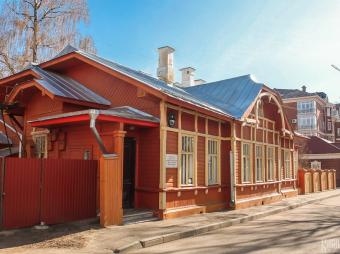
Academics Aleksandr and Boris Arbuzov Memorial-Museum
- 8 Katanovsky Pereulok
- http://www.kazan1000.ru/rus/museum/Arbuzovs1.htm
- 10:00 - 16:00. Closed on weekends.
In 1971 the Academics Aleksandr and Boris Arbuzov Memorial-Museum was opened in the wooden house where Aleksandr Arbuzov and his son Boris lived. The father and son were both famous chemists. Aleksandr is most famous for his work in the field of Organic Chemistry and the Michaelis-Arbuzov Reaction is partly named in his honour. The museum displays many original pieces of furniture, documents and items of the Arbuzovs and has exhibits on the life and work of the family. Read more »
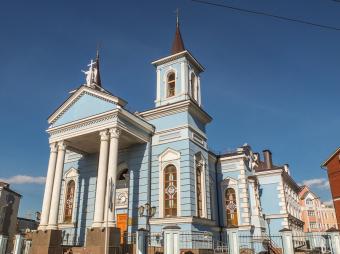
Exaltation of the Cross Roman Catholic Church
- 73 Ulitsa Ostrovskogo
Kazan’s first catholic church was opened in Kazan in 1858 but this was closed down in 1927 and the catholic parish was dissolved. The old church’s building was given over to a technical college. It was only in 1995 that a catholic parish was re-established and plans were initiated to build a new church. Work on the construction started in 2005 and the Exaltation of the Cross Church was completed in 2008, 150 year to the day since the consecration of the first church. The light blue… Read more »
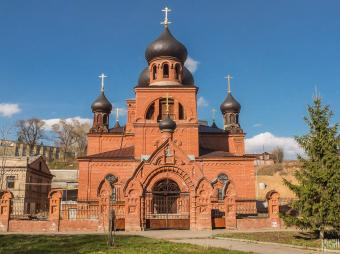
Intercession Old-Believers Eparchial Cathedral
- 11 Ulitsa Ulyanova-Lenina
The Intercession Old-Believers Cathedral was built between 1905 and 1909 after the law granting religious freedom was adopted in Russia. In style the cathedral is very similar to the nearby Our Lady of Kazan Old-Believers Church, but this church has extra domes which are black in colour. Today the cathedral is the Eparchial Cathedral of the Kazan and Vyatka Eparchy of the Russia Old-Believers Orthodox Church. Read more »
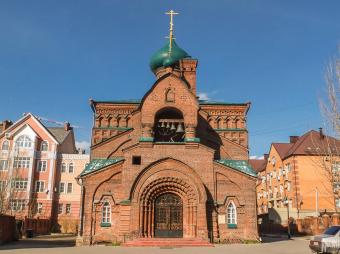
Our Lady of Kazan Old-Believers Church
- 81 Ulitsa Ostrovskogo
Just down from Kazan's Catholic Church is the Our Lady of Kazan Old-Believers Church which was completed in 1912. It was built in the ancient Russian style out of red bricks and with a central green dome. In 1931, not too long after it was opened, the church was closed and it was given over for use as a workshop. In 1988 the building was returned to the Old-Believers community and the church was reopened. Read more »
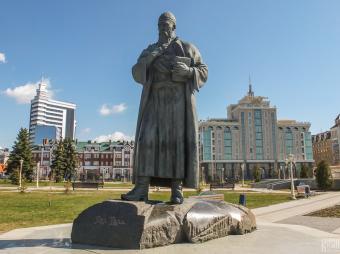
Qol Ğäli Monument and Millennium Fountain
- Millennium Park (next to Ulitsa Ostrovskogo)
Qol Ğäli (sometimes spelled Kul Gali) was a 12th century Volga Bulgar poet considered to be the founder of medieval Tatar Literature. His most famous work is the Qíssai Yosıf (Tale of Yusuf) which he wrote in 1233. This statue to him was unveiled in 2005 as part of Kazan's millennium celebrations in the newly created Millennium Park. Nearby is the interesting Millennium Fountain which features a giant 'kazan' cooking pot and several little zilants. Read more »
Sharif Kamal Museum
- 15 Ulitsa Ostrovskogo
- 10:00 - 18:00. Closed on Sunday and Monday.
Located inside a late-19th century - early-20th century merchant mansion is the Sharif Kamal Museum which was opened in 1980. Sharif Kamal, born Sharif Baigildiev, was a famous Tatar poet and writer, who died in Kazan in 1942 aged 58. This museum includes a memorial room and an exhibition room which displays information on Kamal's life and work. Its main exhibit is a collection of his work which was donated by his daughter. Read more »
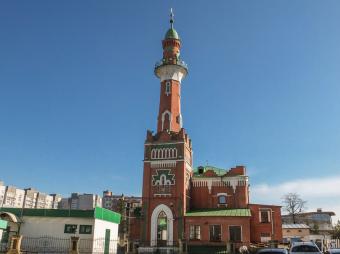
Zakabannaya Mosque
- 26 Ulitsa Taktasha
The red and green Zakabannaya Mosque gets its name as it is located across the Qaban Lake ("za Kaban") away from the majority of mosques in Kazan which are in the Staraya-Tatarskaya Sloboda. It is also known as the Millennium of Islam Mosque as it was built to commemorate the thousandth anniversary of the Volga Bulgars' adoption of Islam in 922. The mosque was built between 1924 and 1926 making it the only mosque to be built in the region during the Soviet period. However this did… Read more »
In the Novaya Tatarskaya Sloboda
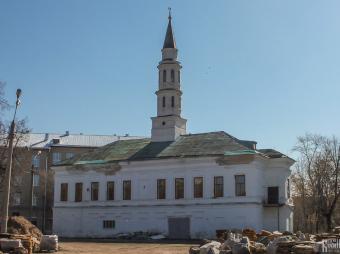
İske Taş (Iske-Tash) Mosque
- 34A Ulitsa Mazita Gafuri
According to legend, after the 1552 conquest of Kazan, Tartar leaders who served under Tsar Ivan the Terrible requested that they be allowed to bury the Tatar dead in the Muslim manner. This was permitted and afterwards they placed a large boulder on the site so that it would be remembered. When foundations were being dug for a new mosque in 1801 the stone was found and the mosque was named İske Taş meaning 'old stone' in Tatar. It is also known as the Ninth Congressional Mosque… Read more »
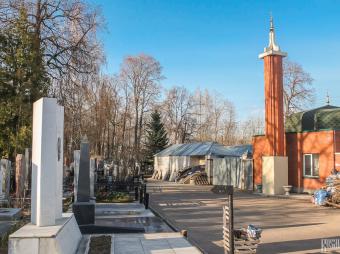
Old Tatar Cemetery
- Ulitsa Mekhovschikov + Ulitsa Yul Uram
The Old Tatar Cemetery in the very south of the Novaya Tatarskaya Sloboda was created along with the new quarter itself in the mid-18th century. The cemetery serves as the final resting place for many famous Tatars, most notably Ğabdulla Tuqay, Qayum Nasıri, Salix Säydäş and Baqi Urmançe. The cemetery now only accepts new burials as part of family tombs as there is no more space left. There is also a small mosque on the territory of the cemetery. Read more »
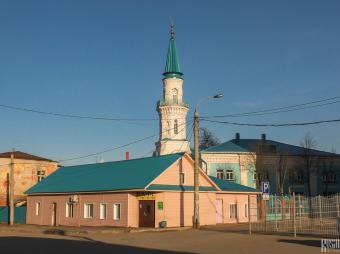
Pink (Rozovaya) Mosque
- 67 Ulitsa Mazita Gafuri
The Pink Mosque is located next to the terminal of a tram line in the Novaya Tatarskaya Sloboda. From its appearance it is unclear why it is called the Pink Mosque as now it is green in colour. It is also known as the Nizenkaya Bukhara Mosque after the Uzbek city. The mosque was built by the merchant Musa Apanaev in 1808 and became the main Islamic centre in the Novaya Tatarskaya Sloboda. However it was closed in 1931 and only reopened in 1991 by which time the Novaya Tatarskaya… Read more »
In the Staraya Tatarskaya Sloboda
Äcem (Azimovskaya) Mosque
- 15 Ulitsa Fatkullina
The Äcem Mosque is also known as the Azimovskaya Mosque from its Russian name and as the Sixth Congressional Mosque. It is a fine example of Tatar religious architecture. It was built between 1867 and 1890 on the site of an old wooden mosque using the funds of local merchant Mortaza Äcimev (Murtaza Azimov). It comprises one large hall attached to a beautifully ornate minaret, standing at 51 metres tall. The mosque was closed between 1930 and 1992. Read more »

Al-Märcani (Al-Mardzjani) Mosque
- 17 Ulitsa Kayma Nasyri
The Märcani Mosque was built between 1766 and 1770 and became the first mosque to be built in Kazan since Ivan the Terrible's 1552 conquest of Kazan. Permission to build the mosque was personally granted by Empress Catherine the Great. The mosque was built in the traditional Tatar style of a building with a central minaret on the roof. Also known as the First Congressional Mosque, it is now named after the Tatar theologian and historian Şihabetdin Märcani, who served as the mosque… Read more »
Apanay (Apanaevskaya) Mosque
- 29 Ulitsa Kayma Nasyri
The Apanay Mosque was built between 1768 and 1771 just after the Al-Märcani Mosque. It bears the name of the merchant Apanaev who donated money for its construction, but it is also referred to as the Second Congressional Mosque. The yellow and green mosque was built in the baroque style. It was closed in 1930 and its minaret was demolished. It was later used as a pre-school. The Apanay Mosque was reopened in 1995 and underwent restoration work which saw its minaret rebuilt. Read more »

Blue (Golubaya) Mosque
- 19/8 Ulitsa Fatykha Karima
The Blue Mosque is also referred to as the Fourth Congressional Mosque. It is known as the Blue Mosque as it was traditionally blue in colour. It was built in the classical style between 1815 and 1819 and further extended in 1864 and 1907. The mosque was closed in 1932 and its minaret was removed shortly afterwards. Throughout the Soviet period it was used as housing, only being reopened as a mosque in 1993. It was not until 2009 that its minaret was restored. Read more »
Bornay (Burnaevskaya) Mosque
- Ulitsa Gabdully Tukaya / Ulitsa Akhtyamova
The red-brick Bornay Mosque, also known as the Third Congressional Mosque, was built in 1872 on the site of an older wooden mosque and bears the name of the merchant who funded the project. In its design it comprises elements of ancient Tatar and Russian architecture. The most striking feature is its elaborate minaret which stands over the entrance. Read more »
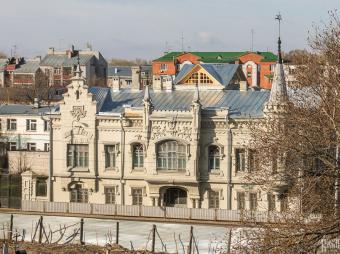
Ğabdulla Tuqay Literary Museum
- 74 Ulitsa Gabdully Tukaya
- http://www.tatar.museum.ru/tukay/
- 10:00 - 17:00, daily except Monday. Free entry on first Wednesday of the month.
The Ğabdulla Tuqay Literary Museum is located in the grand manor house known as Shamil House which was built in 1903. The museum was opened in 1986 and is dedicated to the work and life of the famous Tatar poet Ğabdulla Tuqay (Gabdulla Tukai), who is credited with being the main founder of modern Tatar literature. Read more »
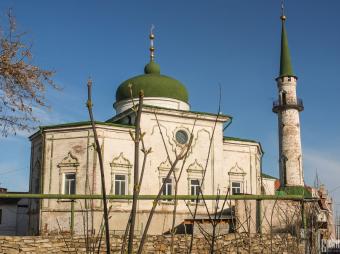
Nurulla Mosque
- 74/15 Ulitsa Moskovskaya
The Nurulla Mosque is also referred to as the Sennaya Mosque after its proximity to the Senny Market and as the Yunusovskaya Mosque after its founder. In addition, it is also known as the Seventh Congressional Mosque. It was built between 1845 and 1849 using the funds of the Yunusov brothers. The white mosque comprises a two-storey building topped with a green cupola and a minaret. The minaret was destroyed in 1929 when the mosque was closed and used as accommodation and offices… Read more »
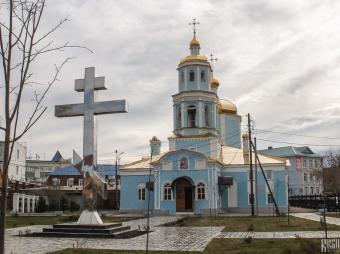
Our Lady of Tikhvin Church
- 4 Ulitsa Khudyakova
The Our Lady of Tikhvin Church is the only surviving Orthodox Church in the Staraya Tatarskaya Sloboda. The original church dates from 1646 and 1685 but this was either completed rebuilt or heavily renovated in the late 18th century. Then between 1898 and 1900 new side-chapels were built on. The church was closed in the Soviet era and only reopened in 1997. Today the church is the central church for the sub-group of Volga Tatars known as Kryashens - namely Tatars who have converted… Read more »
Qayum Nasıri Museum
- 35 Parizhskoy Kommuny
- http://tatar.museum.ru/M2763
- 10:00 - 17:00. Closed on Sundays.
The Qayum Nasıri Museum is dedicated to historian, ethnographer and linguist Qayum Nasiri (also transliterated as Kayum Nasyri), who is also considered one of the founders of the modern Tatar literary language. The museum details the life and work of Nasiri and features many handwritten and printed documents, photographs and letters of the academic. Read more »
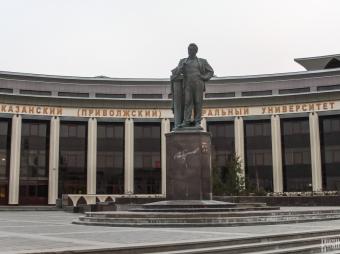
Salix Säydäş Monument
- 2 Ulitsa Tatarstan
Salix Säydäş (sometimes transliterated as Salikh Saidashev) was a famous Tatar composer and conductor who was born near Kazan in 1900. In his career Säydäş made a significant contribution to the development of Tatar music. This monument to him was unveiled in 2005 as part of Kazan's millennium celebration, outside another department of the Kazan (Volga) State University. Read more »
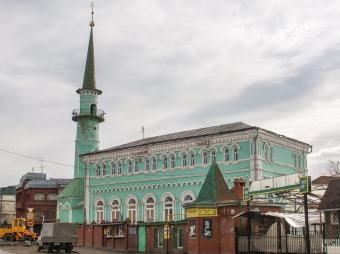
Soltan (Sultanovskaya) Mosque
- 14 Ulitsa Gabdully Tukaya
Standing on the corner of Ulitsa Galiaskara Kamala and Ulitsa Gabdully Tukaya is the immediately noticeable turquoise Soltan Mosque which is also known as the Eighth Congressional Mosque. The mosque dates from 1868. Its construction was funded by the Tatar merchant Ziganshi Usmanov and sometimes it is referred to as the Usmanovskaya Mosque in his honour. It was built in the tradition of medieval Volga-Tatar architecture with a three-tier minaret over its entrance. It was closed in… Read more »
North of the River Kazanka
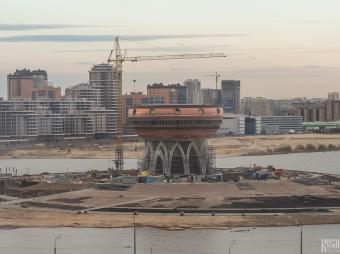
Kazan Monument Registry Office
- Leninskaya Damba
Standing on the bank of the River Kazanka opposite to the Kremlin is a marriage registry office with a big difference as it takes the form of a giant cooking pot known as a kazan. According to legend Kazan gets its name from such a cooking utensil after a servant dropped the golden kazan of a Volga Bulgarian khan into the Kazanka when collecting water. The registry office was opened in July 2013 to replace other registry offices in the city. Read more »
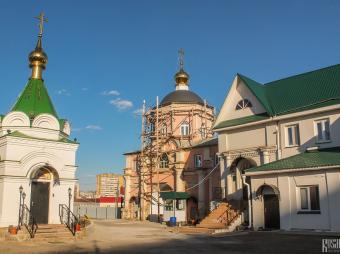
Kizichesky Vvedensky Monastery
- 98 Ulitsa Dekabristov
When an anthrax epidemic broke out in the city in 1654-1655 killing thousands of people, it was decided to bring a wonder-working copy of the Our Lady of Smolensk Icon from the Semiozernaya Bogorodichnaya Hermitage to Kazan so that the populace could pray for a miracle. The epidemic started to subside when the icon was in the city and it was decided to build a monastery on the site where the icon was met in Kazan to show gratitude for the miracle. This was fulfilled in 1701. In… Read more »
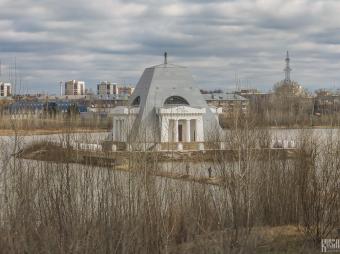
Memorial-Temple to Russian Soldiers who Fell at the Conquest of Kazan
- On an island in River Kazanka
The pyramid located on an island in the River Kazanka and connected to the Kirovskaya Dam by a small mound is a Memorial-Temple to Russian Soldiers who Fell during the Conquest of Kazan. Before the area was flooded in Soviet times to create the Kuibyshevskoe Reservoir the temple stood on the top of a hill, which served as a mass grave for the Russian soldiers who died during the siege and subsequent conquest of Kazan in 1552. The temple which contains a crypt inside was consecrated… Read more »
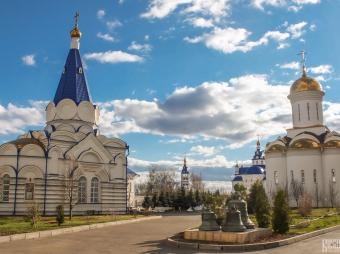
Svyato-Uspensky Zilantov Convent
- Ulitsa Zilantova Gora
Originally a convent was founded in 1552 on the site of mass graves of Russian soldiers killed during the conquest of Kazan, so that the nuns could pray for their souls. However it was later decided that to prevent it from flooding each spring, it should be moved to Zilantova hill, which gets its name from the legend that Zilant, the winged snake-like monster, once lived here. During the Russian Civil War, the White Army and Czechoslovakian Legion set up defences here, but the city… Read more »
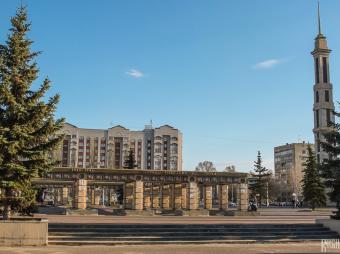
Victory Park
- Prospekt Yamasheva
Kazan's Victory Park (Park Pobedy) was opened in the 1970s when 1418 trees were planted here; one tree to represent each year of the war. In 1995 a memorial complex was created to mark the 50th anniversary of the end of the war. The most striking feature of the complex is the 42 metre Victory Obelisk at the base of which there is a statue of soldiers and a mother with a child in her arms. Next to this is a pantheon featuring marble tiles engraved with the names of heroes from… Read more »
Staroe Arakchino Platform
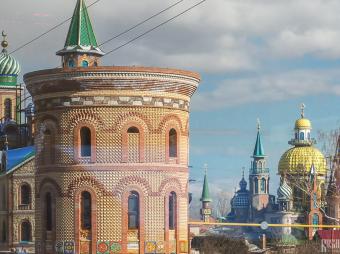
Temple of All Religions
- 2 Ulitsa Privolzhskaya
The Temple of All Religious is a unique architectural ensemble created by Kazan artist and philanthropist Ildar Khanov in 1992 to promote the peaceful coexistence of religions. The complex incorporates a mosque, orthodox church, Buddhist temple and a synagogue; in total it has 16 domes representing 16 world religions. No services are held at the complex, instead it is used as a cultural centre. You can get here by taking a suburban train (electrichka) from Kazan-1-Passenger… Read more »


 History
History
